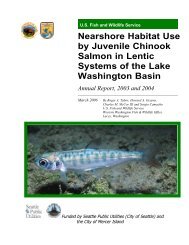2005 State of Mobility Report - City of Bellevue
2005 State of Mobility Report - City of Bellevue
2005 State of Mobility Report - City of Bellevue
Create successful ePaper yourself
Turn your PDF publications into a flip-book with our unique Google optimized e-Paper software.
CHAPTER 6: Neighborhood Programs and Services<br />
For example, historically the Neighborhood Traffic<br />
Calming Program has designed and constructed 3<br />
to 4 large-scale Traffic Calming Projects each year.<br />
The cost <strong>of</strong> these projects now averages $150,000 to<br />
$200,000, due to the extent <strong>of</strong> physical measures being<br />
implemented and the fact that a more comprehensive<br />
look at multiple streets within the affected<br />
neighborhoods is <strong>of</strong>ten warranted. As a result, the<br />
program is struggling to maintain the historical level<br />
<strong>of</strong> service (in terms <strong>of</strong> number and scope <strong>of</strong> projects)<br />
with its annual budget <strong>of</strong> $375,000. The demand for<br />
solutions that require larger scale projects is greater<br />
than the available resources. The same struggle exists<br />
within NEP and RPZ.<br />
The demand for these programs is likely to increase.<br />
In the <strong>2005</strong> <strong>City</strong> <strong>of</strong> <strong>Bellevue</strong> Budget Survey,<br />
<strong>Bellevue</strong> citizens identified controlling traffic in<br />
neighborhoods as one <strong>of</strong> the highest <strong>City</strong>-wide<br />
problems, with 39 percent requesting the <strong>City</strong><br />
do more to address the problem. Another factor<br />
that will increase the demand for services is the<br />
demographic shift occurring in many <strong>of</strong> the older<br />
neighborhoods. Young families with children<br />
are transitioning into these neighborhoods and<br />
have different priorities for what makes their<br />
neighborhoods livable.<br />
To meet these challenges, <strong>City</strong> staff will continue<br />
to look for joint funding opportunities with<br />
other <strong>City</strong> programs and from external sources,<br />
as appropriate. In addition, program staff will<br />
seek to build even stronger and more creative<br />
working relationships with <strong>Bellevue</strong> residents to<br />
ensure the quality <strong>of</strong> life in their neighborhoods is<br />
uncompromised by traffic concerns.<br />
<strong>2005</strong> <strong>State</strong> <strong>of</strong> <strong>Mobility</strong> <strong>Report</strong> Chapter 6 53

















